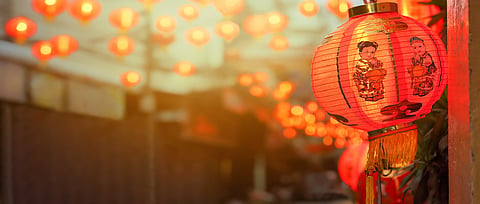Have you been to Kolkatas China Towns during the Lunar New Year
The candy pink lion jumped higher and higher to catch the bunch of lettuce leaves hung from a pole extending out of a second floor window of a building. Every time, the lion was about to chomp on the lettuce, it was pulled back. But this was one patient lion. And after several tries, it succeeded. The crowd clapped in glee while the group of boys who had donned the lion mantle doffed their cape in acknowledgement and extracted the red packet (containing some monetary gift) from the lettuce. I was standing in a corner of the Tiretta Bazar neighbourhood of central Kolkata watching the Chinese New Year unfold in the city.
But which lion eats veggies A senior member of the community explained that the secret lay in the Chinese language or rather how the words are written or pronounced. Although I found the Chinese homophones a bit confusing to follow, simply put, it meant the Chinese (Cantonese) word for &lsquolettuce&rsquo sounded almost like the word that meant &lsquoto get rich&rsquo by varying the tone of the pronunciation.

As we waited for the next lion dance, a group of young people ran past holding aloft a colourful dragon with a long body. The dragon was held up by a series of poles along its length, and wiggled to make it dance to the orchestrated rhythm of drums. A crowd followed in its wake. &ldquoIt is not as easy as it seems,&rdquo filled in my companion Liu, &ldquothey have to practice for months to attain that fluid movement in sync with the drums.&rdquo According to many, the longer a dragon dances, the more propitious it is for the community.
With a sizeable number of Chinese families calling Kolkata home (though their numbers have dwindled in the recent past), the city has two China Towns &ndash the older one located around Tiretta Bazar in the heart of Kolkata and the other one in Tangra, along the eastern fringe of the city. While the Chinese families have been celebrating their festivities for many years, their New Year celebration has become a key attraction for the city. So, if you are in Kolkata during the Chinese New Year (February 5 this year), do not miss a chance to enjoy the festivities.
Both at Tiretta Bazar and Tangra, preparations begin months ahead, with the pace picking up as New Year approaches. Flags with Chinese calligraphy have to be made, the dragons and lions from the previous years have to be readied, the orchestra and dance movements rehearsed. Usually, the Indian Chinese Association for Culture, Welfare and Development holds a Lion Dance and Cultural festival in Tiretta Bazar a few days ahead (on Feb 3 this year) of the actual festival. During the festival, the temples and other buildings are decorated and illuminated.
On New Year&rsquos Day, the Chinese visit the various temples located in both neighbourhoods. Some of the old temples are located in Tiretta Bazar, such as Toong On (Nan King restaurant &ndash now shut &ndash which opened on its premises back in 1924 is said to be the first Chinese eatery in Kolkata), Sea Ip, Gee Hing, Nam Soon, Sea Voi Yune Leong Futh, and Choonghee Dong Thien Haue.
Various Chinese clubs then hold lion and dragon dances, running through the lanes and by-lanes of the neighbourhoods, during the day. They visit homes and shops, often receiving token gifts in red packets. The lion and dragon dancing are part of quintessential Chinese culture and are performed to usher in good luck and fortune. Bursting crackers is also a part of the festival.

On the Sunday after the Lunar New Year, the community observes a festival unique to the Kolkata-based Chinese families. Even those who have migrated abroad, often return to the city, to pay respect to the grave of Tong Achew located at a place called Achipur (near Budge Budge), about 30km to the south-west of Kolkata. According to most records, Atchew or Tong Achew was the first Chinese to settle down in Calcutta (as Kolkata was then known as) in the late 18th century. An entry in the Bengal District Gazetteers 24 Parganas says Tong Achew was given a grant of land by East India Company&rsquos Governor General Warren Hastings where he set up a sugar manufacturing plant.
Before visiting the grave, which is located on the bank of the Hooghly River, they stop at a temple in Achipur town. Enshrined in the temple are the deities of the Earth God and Goddess (Khuda Khudi). They offer a variety of food and drinks, which is a most interesting sight. A long table placed in front of the shrine is piled high with tea, coke and exotic wines, fruits, cakes, biscuits, wafers, dumplings, dressed chickens, etc. Although little is known about the temple and the twin idols, it is believed that they were brought by Achew as guardian deities. Food offerings, on a smaller scale, are also made at the red-coloured horse-shoe shaped grave. The food offered at the temple are consumed by the pilgrims as part of a picnic lunch.
The Chinese community welcomes members of all communities to share the festive cheer. Even the temple and grave at Achhipur are open to everyone, so long as the pilgrims are not disturbed or the rituals interrupted.


